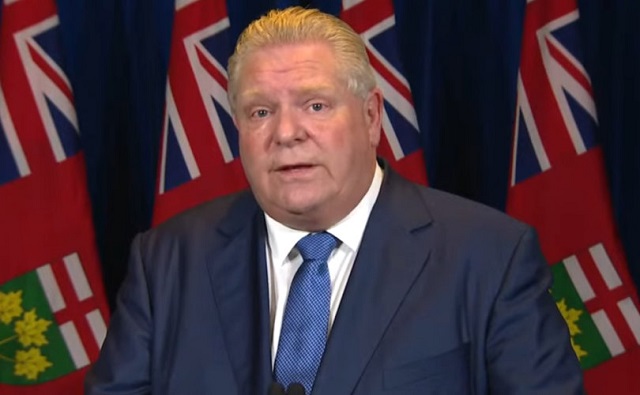Business
Ontario Premier Doug Ford Apologizes To Americans After Threatening Energy Price Hike For Millions


From the Daily Caller News Foundation
By
Ontario Premier Doug Ford apologized to Americans Tuesday after he suspended a 25% electricity surcharge that he initially said he would be “relentless” in pursuing.
Ford implemented a 25% surcharge on electricity to New York, Michigan and Minnesota on Monday, but quickly rescinded the policy and apologized to Americans on WABC’s “Cats & Cosby” radio show the following day. The tariffs were initially a retaliatory measure against President Donald Trump’s flurry of tariffs against Canada since he assumed office.
Canada is highly dependent on U.S. exports, economists told CNN, and the planned electricity surcharge would likely hurt Canada’s energy industry much more than it would the U.S., although an estimated 1.5 million homes and businesses would have been affected.
Dear Readers:
As a nonprofit, we are dependent on the generosity of our readers.
Please consider making a small donation of any amount here.
Thank you!
“I want to apologize to the American people. I spent 20 years of my life in the US, in New Jersey, in Chicago. I love the American people,” Ford said. “I absolutely love them … Secretary Lutnick and President Trump are brilliant businesspeople. They are hard negotiators. We need to put this behind us and move forward and build the two strongest countries in the world.”
Initially, Ford had a much more aggressive tone when he instituted the tariffs.
“We will not back down. We will be relentless. I apologize to the American people that President Trump decided to have an unprovoked attack on our country, on families, on jobs, and it’s unacceptable,” Ford said on MSNBC in response to Trump’s hiking of steel and aluminum tariffs.
Trump, in turn, threatened to increase the steel and aluminum tariffs on Canada to 50%, with the increase going into effect the next day.
Ford then talked with Secretary of Commerce Howard Lutnick, with the premier describing the call as “productive.” Once Ford backed down on his plan to implement the export fees, Trump reversed his planned hike to 50% on steel and aluminum tariffs. Ford is expected to meet with Lutnick Thursday in Washington, D.C.
If a deal is not reached by the April 2 deadline, the tariffs will resume.
Ontario sold around 12 terawatt hours of electricity to America in 2023, with the U.S. being Ontario’s largest energy customer outside Canada. The tariff would have likely added “100$ a month” to the bill of Americans in the affected states, Ford claimed according to CNN.
The U.S. and Canada have entered into a contested debate over trade policies, with Canada announcing an additional $20 billion in retaliatory tariffs on American goods in response to Trump’s initial 25% steel and aluminum tariffs.
Trump initially gained concessions from Canada in February, forcing them to aid in curtailing the illegal fentanyl trade in exchange for a pause on a 25% general goods tariff enacted Feb. 1. However, Trump eventually let the pause expire, with the tariff resuming in March.
“Canada is a tariff abuser, and always has been, but the United States is not going to be subsidizing Canada any longer,” Trump said on Truth Social Mar. 10.
The Ontario Premier’s office did not immediately respond to the Daily Caller News Foundation’s request for comment.
Business
Canada’s critical minerals are key to negotiating with Trump

From Resource Works
The United States wants to break its reliance on China for minerals, giving Canada a distinct advantage.
Trade issues were top of mind when United States President Donald Trump landed in Kananaskis, Alberta, for the G7 Summit. As he was met by Prime Minister Mark Carney, Canada’s vast supply of critical minerals loomed large over a potential trade deal between North America’s two largest countries.
Although Trump’s appearance at the G7 Summit was cut short by the outbreak of open hostilities between Iran and Israel, the occasion still marked a turning point in commercial and economic relations between Canada and the U.S. Whether they worsen or improve remains to be seen, but given Trump’s strategy of breaking American dependence on China for critical minerals, Canada is in a favourable position.
Despite the president’s early exit, he and Prime Minister Carney signed an accord that pledged to strike a Canada-US trade deal within 30 days.
Canada’s minerals are a natural advantage during trade talks due to the rise in worldwide demand for them. Without the minerals that Canada can produce and export, it is impossible to power modern industries like defence, renewable energy, and electric vehicles (EV).
Nickel, gallium, germanium, cobalt, graphite, and tungsten can all be found in Canada, and the U.S. will need them to maintain its leadership in the fields of technology and economics.
The fallout from Trump’s tough talk on tariff policy and his musings about annexing Canada have only increased the importance of mineral security. The president’s plan extends beyond the economy and is vital for his strategy of protecting American geopolitical interests.
Currently, the U.S. remains dependent on China for rare earth minerals, and this is a major handicap due to their rivalry with Beijing. Canada has been named as a key partner and ally in addressing that strategic gap.
Canada currently holds 34 critical minerals, offering a crucial potential advantage to the U.S. and a strategic alternative to the near-monopoly currently held by the Chinese. The Ring of Fire, a vast region of northern Ontario, is a treasure trove of critical minerals and has long been discussed as a future powerhouse of Canadian mining.
Ontario’s provincial government is spearheading the region’s development and is moving fast with legislation intended to speed up and streamline that process. In Ottawa, there is agreement between the Liberal government and Conservative opposition that the Ring of Fire needs to be developed to bolster the Canadian economy and national trade strategies.
Whether Canada comes away from the negotiations with the US in a stronger or weaker place will depend on the federal government’s willingness to make hard choices. One of those will be ramping up development, which can just as easily excite local communities as it can upset them.
One of the great drags on the Canadian economy over the past decade has been the inability to finish projects in a timely manner, especially in the natural resource sector. There was no good reason for the Trans Mountain pipeline expansion to take over a decade to complete, and for new mines to still take nearly twice that amount of time to be completed.
Canada is already an energy powerhouse and can very easily turn itself into a superpower in that sector. With that should come the ambition to unlock our mineral potential to complement that. Whether it be energy, water, uranium, or minerals, Canada has everything it needs to become the democratic world’s supplier of choice in the modern economy.
Given that world trade is in flux and its future is uncertain, it is better for Canada to enter that future from a place of strength, not weakness. There is no other choice.
Business
Rhetoric—not evidence—continues to dominate climate debate and policy

From the Fraser Institute
Myths, fallacies and ideological rhetoric continue to dominate the climate policy discussion, leading to costly and ineffective government policies,
according to a new study published today by the Fraser Institute, an independent, nonpartisan Canadian public policy think-tank.
“When considering climate policies, it’s important to understand what the science and analysis actually show instead of what the climate alarmists believe to be true,” said Kenneth P. Green, Fraser Institute senior fellow and author of Four Climate Fallacies.
The study dispels several myths about climate change and popular—but ineffective—emission reduction policies, specifically:
• Capitalism causes climate change: In fact, according to several environment/climate indices and the Fraser Institute’s annual Economic Freedom of the World Index, the more economically free a country is, the more effective it is at protecting its environment and combatting climate change.
• Even small-emitting countries can do their part to fight climate change: Even if Canada reduced its greenhouse gas emissions to zero, there would be
little to no measurable impact in global emissions, and it distracts people from the main drivers of emissions, which are China, India and the developing
world.
• Vehicle electrification will reduce climate risk and clean the air: Research has shown that while EVs can reduce GHG emissions when powered with
low-GHG energy, they often are not, and further, have offsetting environmental harms, reducing net environmental/climate benefits.
• Carbon capture and storage is a viable strategy to combat climate change: While effective at a small scale, the benefits of carbon capture and
storage to reduce global greenhouse gas emissions on a massive scale are limited and questionable.
“Citizens and their governments around the world need to be guided by scientific evidence when it comes to what climate policies make the most sense,” Green said.
“Unfortunately, the climate policy debate is too often dominated by myths, fallacies and false claims by activists and alarmists, with costly and ineffective results.”

Kenneth P. Green
Senior Fellow, Fraser Institute
-

 Business1 day ago
Business1 day agoThe CBC is a government-funded giant no one watches
-

 conflict2 days ago
conflict2 days agoTrump leaves G7 early after urging evacuation of Tehran
-

 conflict1 day ago
conflict1 day agoMiddle East clash sends oil prices soaring
-

 Crime2 days ago
Crime2 days agoUK finally admits clear evidence linking Pakistanis and child grooming gangs
-

 Also Interesting2 days ago
Also Interesting2 days agoHow to Use Bonuses at Magius Casino and Similar Websites
-

 conflict1 day ago
conflict1 day agoTrump Threatens Strike on Khamenei as Israel Pounds Iranian Military Command
-

 Alberta1 day ago
Alberta1 day agoAlberta is investing up to $50 million into new technologies to help reduce oil sands mine water
-

 Business1 day ago
Business1 day agoTrump makes impact on G7 before he makes his exit






